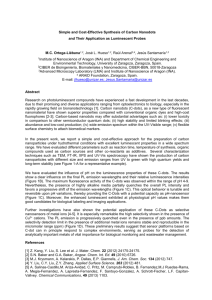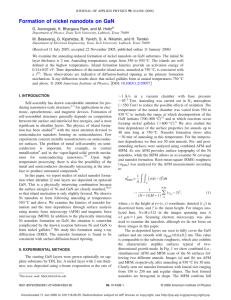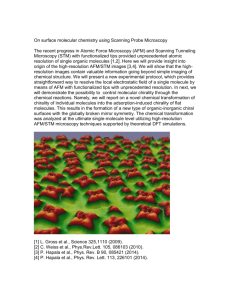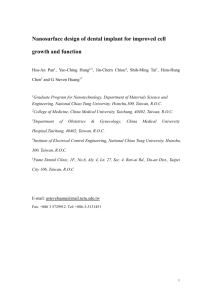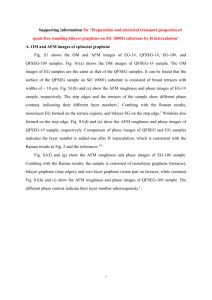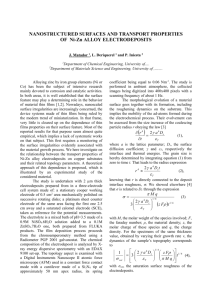Self-assembly of faceted Ni nanodots on Si 111 „ …
advertisement
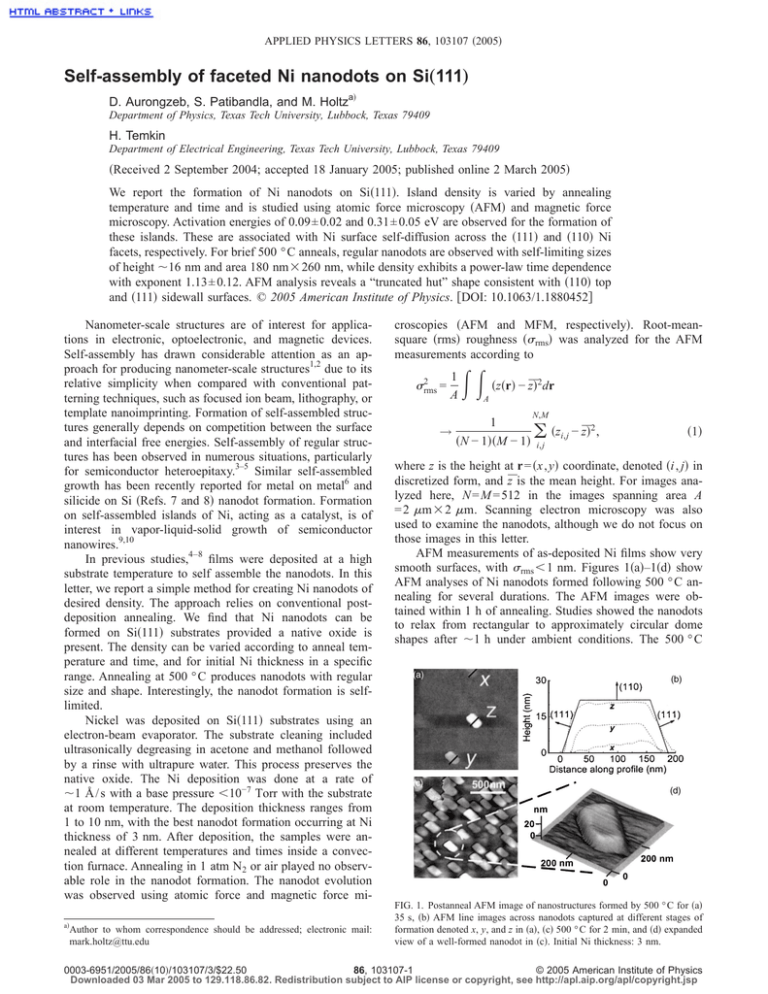
APPLIED PHYSICS LETTERS 86, 103107 共2005兲 Self-assembly of faceted Ni nanodots on Si„111… D. Aurongzeb, S. Patibandla, and M. Holtza兲 Department of Physics, Texas Tech University, Lubbock, Texas 79409 H. Temkin Department of Electrical Engineering, Texas Tech University, Lubbock, Texas 79409 共Received 2 September 2004; accepted 18 January 2005; published online 2 March 2005兲 We report the formation of Ni nanodots on Si共111兲. Island density is varied by annealing temperature and time and is studied using atomic force microscopy 共AFM兲 and magnetic force microscopy. Activation energies of 0.09± 0.02 and 0.31± 0.05 eV are observed for the formation of these islands. These are associated with Ni surface self-diffusion across the 共111兲 and 共110兲 Ni facets, respectively. For brief 500 ° C anneals, regular nanodots are observed with self-limiting sizes of height ⬃16 nm and area 180 nm⫻ 260 nm, while density exhibits a power-law time dependence with exponent 1.13± 0.12. AFM analysis reveals a “truncated hut” shape consistent with 共110兲 top and 共111兲 sidewall surfaces. © 2005 American Institute of Physics. 关DOI: 10.1063/1.1880452兴 Nanometer-scale structures are of interest for applications in electronic, optoelectronic, and magnetic devices. Self-assembly has drawn considerable attention as an approach for producing nanometer-scale structures1,2 due to its relative simplicity when compared with conventional patterning techniques, such as focused ion beam, lithography, or template nanoimprinting. Formation of self-assembled structures generally depends on competition between the surface and interfacial free energies. Self-assembly of regular structures has been observed in numerous situations, particularly for semiconductor heteroepitaxy.3–5 Similar self-assembled growth has been recently reported for metal on metal6 and silicide on Si 共Refs. 7 and 8兲 nanodot formation. Formation on self-assembled islands of Ni, acting as a catalyst, is of interest in vapor-liquid-solid growth of semiconductor nanowires.9,10 In previous studies,4–8 films were deposited at a high substrate temperature to self assemble the nanodots. In this letter, we report a simple method for creating Ni nanodots of desired density. The approach relies on conventional postdeposition annealing. We find that Ni nanodots can be formed on Si共111兲 substrates provided a native oxide is present. The density can be varied according to anneal temperature and time, and for initial Ni thickness in a specific range. Annealing at 500 ° C produces nanodots with regular size and shape. Interestingly, the nanodot formation is selflimited. Nickel was deposited on Si共111兲 substrates using an electron-beam evaporator. The substrate cleaning included ultrasonically degreasing in acetone and methanol followed by a rinse with ultrapure water. This process preserves the native oxide. The Ni deposition was done at a rate of ⬃1 Å / s with a base pressure ⬍10−7 Torr with the substrate at room temperature. The deposition thickness ranges from 1 to 10 nm, with the best nanodot formation occurring at Ni thickness of 3 nm. After deposition, the samples were annealed at different temperatures and times inside a convection furnace. Annealing in 1 atm N2 or air played no observable role in the nanodot formation. The nanodot evolution was observed using atomic force and magnetic force mia兲 Author to whom correspondence should be addressed; electronic mail: mark.holtz@ttu.edu croscopies 共AFM and MFM, respectively兲. Root-meansquare 共rms兲 roughness 共rms兲 was analyzed for the AFM measurements according to 2 rms = 1 A → 冕冕 共z共r兲 − z̄兲2dr A 1 共N − 1兲共M − 1兲 N,M 共zi,j − z̄兲2 , 兺 i,j 共1兲 where z is the height at r = 共x , y兲 coordinate, denoted 共i , j兲 in discretized form, and z̄ is the mean height. For images analyzed here, N = M = 512 in the images spanning area A = 2 m ⫻ 2 m. Scanning electron microscopy was also used to examine the nanodots, although we do not focus on those images in this letter. AFM measurements of as-deposited Ni films show very smooth surfaces, with rms ⬍ 1 nm. Figures 1共a兲–1共d兲 show AFM analyses of Ni nanodots formed following 500 ° C annealing for several durations. The AFM images were obtained within 1 h of annealing. Studies showed the nanodots to relax from rectangular to approximately circular dome shapes after ⬃1 h under ambient conditions. The 500 ° C FIG. 1. Postanneal AFM image of nanostructures formed by 500 ° C for 共a兲 35 s, 共b兲 AFM line images across nanodots captured at different stages of formation denoted x, y, and z in 共a兲, 共c兲 500 ° C for 2 min, and 共d兲 expanded view of a well-formed nanodot in 共c兲. Initial Ni thickness: 3 nm. 0003-6951/2005/86共10兲/103107/3/$22.50 86, 103107-1 © 2005 American Institute of Physics Downloaded 03 Mar 2005 to 129.118.86.82. Redistribution subject to AIP license or copyright, see http://apl.aip.org/apl/copyright.jsp 103107-2 Appl. Phys. Lett. 86, 103107 共2005兲 Aurongzeb et al. FIG. 2. Arrhenius plot of island density 共쎲兲. Activation energies are obtained from fits to the data in the low and high anneal temperature ranges 共dashed lines兲. The rms roughness evolution is also shown 共䊊兲. The solid curve is calculated rms roughness based on the density and uniform nanodot shapes. anneals produced the truncated trapezoidal shapes shown in Fig. 1 with lateral dimensions 180± 10 nm by 260± 14 nm and thickness 16± 5 nm. Uncertainties are standard deviations. An enlarged view of a well-formed nanodot in Fig. 1共c兲 is shown in Fig. 1共d兲. The density is seen to increase with anneal time, but the sizes are found to be consistent, suggesting self-limited formation. Figure 1共b兲 shows line images across nanodots at different stages of formation in Fig. 1共a兲 共x, y, and z兲. We discuss later the morphology of these structures. Combined AFM and MFM images were obtained for island formation following 30 min anneals at several temperatures. Results are from images for fully relaxed nanodots, i.e., more than 1 h at room temperature following the annealing. AFM and MFM images showed the expected agreement. The island density n is found to increase with anneal temperature, while nanodot sizes are approximately uniform up to the highest temperature studied, with lateral length scale ⬃100 nm and height h ⬃ 10 nm. These images were collected after several hours and thus correspond to relaxed nanodots. Nanodots formed by annealing at 600 ° C are substantially smaller, with lateral length scale ⬃30 nm. Figure 2 shows an Arrhenius plot of island density. The observed dependence is consistent with two activation energies. In the low anneal temperature range, we obtain EA ⬃ 0.09± 0.02 eV, while at higher temperatures the dependence yields EA ⬃ 0.31± 0.05 eV. These activation energies are relatively low, suggesting surface diffusion as a likely mechanism for our Ni nanodot formation. Calculated values of Ni self-diffusion, across major crystal facets are EA共111兲 = 0.063 eV, EA共110兲 = 0.39 eV, and EA共100兲 = 0.68 eV.11 Our measured EA results are in reasonable agreement with the calculated values for activated surface diffusion of Ni on 共111兲 and 共110兲 surfaces. The formation kinetics are thus consistent with diffusion-driven growth primarily across these two crystal surfaces. Returning to the anneal time dependence at 500 ° C, two aspects are interesting. First, the island density increases with anneal time. Second, the size and shape of the structures does not appear to depend strongly on anneal time, with slightly taller nanodots formed by the longest anneal duration. Figure 3 shows the island density versus anneal time on FIG. 3. Time dependence of the island density 共쎲兲 and rms roughness 共䊊兲. The dashed lines illustrate the power law behavior with exponents shown. The solid curve is calculated rms roughness based on the density and uniform nanodot shapes. Initial Ni thickness: 3 nm. a log-log scale. We observe a linear dependence such that n ⬀ t, where t is the anneal time and  is the growth exponent. The observed growth is consistent with a power-law behavior with island growth exponent I = 1.13± 0.12. This value is consistent with 1.29± 0.07 reported for ErSi2 nanodot ripening on silicon,8 which was interpreted as illustrating a direct dependence with time. The growth of our Ni nanodots is likewise interpreted as being in proportion to anneal time, although the formation is not a ripening process. We do not observe the island density saturation expected ⬃200 s. It is possible that the additional volume apparent in the nanodots arises from Si diffusion into the region. An elevated AFM tip radius could also contribute to the apparent volume, the tips used here have a nominal tip radius of 10 nm. We will return to the nanodots volume when we discuss nucleation of the nanodots. Figure 2 includes rms roughness versus 1 / kT and Fig. 3 graphs rms versus anneal time at 500 ° C. rms roughness values were determined from the AFM images. In each case, rms increases with island density. A direct connection between the island area density and rms is found as follows. We assume isolated structures having uniform shape with area A0 and height h. The dimensionless area fill factor is defined as f A = nA0. Using the definition of rms roughness 共integral form兲, we obtain by straightforward integration rms = 冑nA0共1 − nA0兲h. 共2兲 Using the island density dependence in the respective graphs and h from the AFM images, we arrive at the solid curves shown in Figs. 2 and 3. The good agreement between the measured rms and this straightforward analysis supports, on statistical grounds, the uniformity in our nanodot formation. In Fig. 3, the roughness is also well fit by a linear dependence such that rms ⬀ t. The exponent obtained from linear fit is R = 0.46± 0.08. This value is consistent with what is expected from Eq. 共2兲, in the low f A limit, when n ⬀ t and A0 is constant. It is also consistent with what is expected for interface evolution in the presence of random pinning forces.12 In the current context, the randomness is related to the nucleation sites where the nanodots form, while the pinning is attributed to Ni atoms being trapped by nanodots once they arrive by surface diffusion. This interpretation is consistent with the fact that we do not observe ripening. Downloaded 03 Mar 2005 to 129.118.86.82. Redistribution subject to AIP license or copyright, see http://apl.aip.org/apl/copyright.jsp 103107-3 Appl. Phys. Lett. 86, 103107 共2005兲 Aurongzeb et al. We now discuss the self-limiting behavior. Figure 1共a兲 shows an AFM image following a very brief anneal at 500 ° C. Some islands are already well-formed, resembling the islands formed after longer anneals 关Fig. 1共c兲兴. Additionally, we capture several islands in the early stages of formation 关denoted by scan lines x, y, and z in Fig. 1共a兲兴. In Fig. 1共b兲, we show representative AFM line profiles across islands at different levels of development. Each island exhibits a similar lateral extent. For fully formed structures, the top surfaces are flat, and the sidewalls make an angle of ⬃37° with the base. This shape is highly repeatable. In the spirit of Ref. 6, we also include in Fig. 1共b兲 a sketch of the “truncated hut” shape we propose based on the AFM images. The shape of our fully formed structures is consistent with a top surface with Ni 共110兲 facet and 共111兲 sidewalls. This assignment is also in accord with the two surface diffusion activation energies obtained from our kinetics studies, which were consistent with EA共111兲 and EA共110兲. This agreement suggests that the formation process involves diffusion across these surfaces. Because the 共111兲 surface has lower surface energy13 and lower surface diffusion activation energy,11 it forms more rapidly than the 共110兲 surfaces, which only fully form in the final stages. The presence of the native oxide plays a key role in the nanodot formation. We have attempted to form Ni nanodots using the same procedures but on Si共111兲, which has been stripped of oxide, and on Si共111兲 with a thermal oxide 共100 nm兲. In both cases, uniform properties are obtained and Ni nanodots are not observed. Native oxides are known to be nonuniform in coverage. Since Ni can diffuse through voids in SiO2,14,15 a patchy native oxide layer will permit this diffusion, and subsequent NiSi2 growth.16 We suggest here that formation occurs where the native oxide is thin. In the 500 ° C temperature range, Ni diffusion through the oxide layer and agglomeration on the surface compete.15 As established here, surface diffusion of Ni on Ni is the primary formation mechanism. Once the NiSi2 nucleation sites form, Ni atoms diffusing across the surface will tend to agglomerate at these places contributing to the nanodot formation. The MFM measurements confirm that the surfaces of our nanodots are magnetic. It is possible that Si will diffuse from the bulk into the regions where NiSi2 has formed, since extended defects occur in the nearby silicon. These extended defects act as fast diffusion paths for the silicon.17 Thus, it is possible that some of the elevation seen in our nanodots stems from this local enhancement of silicon and the volume expansion inherent in silicide formation. We now discuss factors relevant to the self-limited growth. Initially, formation occurs with predominantly 共111兲 and 共110兲 Ni surfaces, due to their lower formation energies.13 The former grow, but diffusion tends to enhance the 共110兲 formation. This is because Ni atoms readily traverse the 共111兲 surfaces, and are slowed when they arrive at a 共110兲 facet. The 共110兲 and 共111兲 surfaces are prevalent in the equilibrium structures, Fig. 1. As growth proceeds, nearby reservoirs of Ni atoms are depleted, contributing to the self-limiting behavior. The highly regular shapes observed in Fig. 1 suggest that stress may play a role in the nanodot formation.7,8 In our current picture, the substratenanodot stress would primarily originate at the Ni/ NiSi2 interface. Lattice constant mismatches between these materials are enormous, ⬃35%,6 so that epitaxy is impossible. Furthermore, we do not know how the lateral extent of the NiSi2 compares with the observed nanodots. Application of the Tersoff and Tromp model,3 relating surface and interface energies to optimal conformation, suggests ⬃1% mismatch strain between the Ni and the underlying material. The observation that relaxation into dome shapes occurs after several hours indicates that the surface and interface energies are comparable. That is, the Ni nanodots formed at 500 ° C, shown in Fig. 1, are close to the maximum size achievable with a rectangular shape. For comparison, the stable Ni nanodots formed on TiN are ⬃25 nm across,6 considerably smaller than what we report here. In contrast, the ErSi2 共Ref. 7兲 and TiSi2 共Ref. 8兲 nanodots on Si共111兲 substrates are elongated. It was concluded that the mismatch strains, in these two cases, were smaller than expected due to the formation of extended defects. Given the anistropic nature of the surface used in preparing our nanodots, it is possible that extended defects are important here as well in mitigating the mismatch strain between Ni and NiSi2. In summary, we have prepared magnetic Ni nanodots using a straightforward, postdeposition annealing approach. Activation energies are determined and related to surface diffusion of Ni across 共111兲 and 共110兲 Ni facets. Detailed studies in the 500 ° C anneal temperature range reveal regular shapes with self-limited sizes. The structures are found to have regular truncated hut shapes consistent with 共110兲 top and 共111兲 sidewall surfaces. These structures are observed to relax into stable dome shapes after ⬃1 h in ambient conditions, suggesting that stress plays a role in the shape along with the formation diffusion kinetics and Ni reservoir depletion. The nanodots do not coalesce. This can be attributed to the Ni depletion, and also, in the regular structures, the presence of strain-field repulsion18 which will be greater near their bases.19 The authors acknowledge support of this research by the National Science Foundation 共CTS–0210141 and ECS– 0304224兲. H. Omi and T. Ogino, Appl. Phys. Lett. 71, 2163 共1997兲. J. Nogami, B. Z. Liu, M. V. Katkov, C. Ohbuchi, and N. O. Birge, Phys. Rev. B 63, 233305 共2001兲. 3 F. M. Ross, J. Tersoff, and R. M. Tromp, Phys. Rev. Lett. 80, 984 共1998兲. 4 G. Medeiros-Ribeiro, T. I. Kamins, D. A. A. Ohlberg, and S. R. Williams, Phys. Rev. B 58, 3533 共1998兲. 5 A. Rastelli, H. von Kanel, B. J. Spencer, and J. Tersoff, Phys. Rev. B 68, 115301 共2003兲. 6 H. Zhou, D. Kumar, A. Kvit, A. Tiwari, and J. Narayan, J. Appl. Phys. 94, 4841 共2003兲. 7 L. Fitting, M. C. Zeman, W.-C. Yang, and R. J. Nemanich, J. Appl. Phys. 93, 4180 共2003兲. 8 W.-C. Yang, H. Ade, and R. J. Nemanich, J. Appl. Phys. 95, 1572 共2004兲. 9 J. Zhang and L. Zhang, J. Vac. Sci. Technol. B 21, 2415 共2003兲. 10 G. Kipshidze, B. Yavich, A. Chandolu, J. Yun, V. Kuryatkov, D. Aurongzeb, I. Ahmad, M. Holtz, and H. Temkin, Appl. Phys. Lett. 86, 033104 共2005兲. 11 U. Kürpick, Phys. Rev. B 64, 075418 共2001兲. 12 H. Leschhorn, Physica A 195, 324 共1993兲. 13 L. Vitos, A. V. Ruban, H. L. Skriver, and J. Kollár, Surf. Sci. 411, 186 共1998兲. 14 H. Dallaporta, M. Liehr, and J. E. Lewis, Phys. Rev. B 41, 5075 共1990兲. 15 J. O. Olowolafe, M.-A. Nicolet, and J. W. Mayer, Thin Solid Films 38, 143 共1976兲. 16 R. T. Tung, J. M. Gibson, and J. M. Poate, Phys. Rev. Lett. 50, 429 共1983兲. 17 D. Jones and V. Palermo, Appl. Phys. Lett. 80, 673 共2002兲. 18 A. Ponchet, D. Lacombe, L. Durand, D. Alquier, and J.-M. Cardonna, Appl. Phys. Lett. 72, 2984 共1998兲. 19 D. E. Jesson, T. P. Munt, V. A. Shchukin, and D. Bimberg, Phys. Rev. Lett. 92, 115503 共2004兲. Downloaded 03 Mar 2005 to 129.118.86.82. Redistribution subject to AIP license or copyright, see http://apl.aip.org/apl/copyright.jsp 1 2
